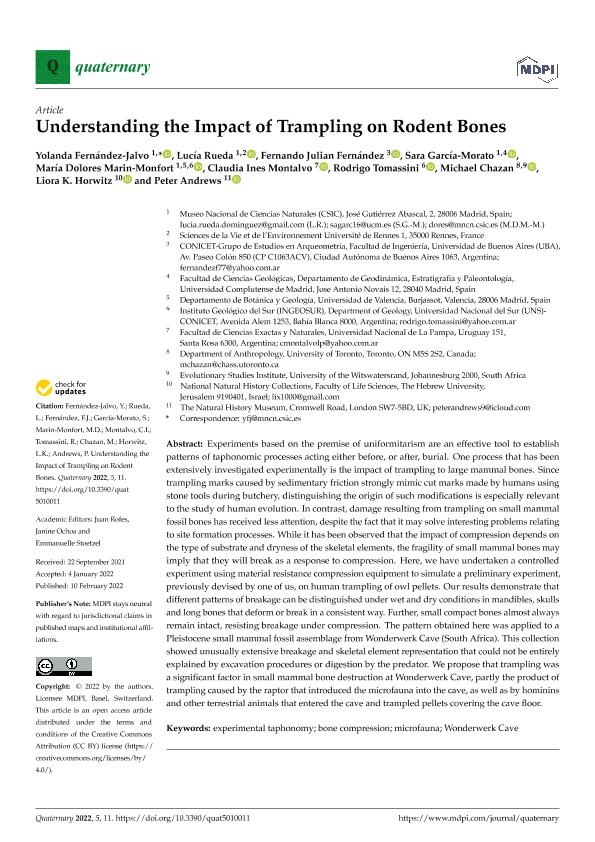Mostrar el registro sencillo del ítem
dc.contributor.author
Fernández Jalvo, Yolanda
dc.contributor.author
Rueda, Lucía

dc.contributor.author
Fernández, Fernando Julián

dc.contributor.author
García Morato, Sara

dc.contributor.author
Marin Monfort, María Dolores

dc.contributor.author
Montalvo, Claudia Inés

dc.contributor.author
Tomassini, Rodrigo Leandro

dc.contributor.author
Chazan, Michael
dc.contributor.author
Horwitz, Liora K.
dc.contributor.author
Andrews, Peter
dc.date.available
2023-05-03T11:12:20Z
dc.date.issued
2022-03
dc.identifier.citation
Fernández Jalvo, Yolanda; Rueda, Lucía; Fernández, Fernando Julián; García Morato, Sara; Marin Monfort, María Dolores; et al.; Understanding the Impact of Trampling on Rodent Bones; MDPI; Quaternary; 5; 1; 3-2022; 1-19
dc.identifier.issn
2571-550X
dc.identifier.uri
http://hdl.handle.net/11336/196044
dc.description.abstract
Experiments based on the premise of uniformitarism are an effective tool to establish patterns of taphonomic processes acting either before, or after, burial. One process that has been extensively investigated experimentally is the impact of trampling to large mammal bones. Since trampling marks caused by sedimentary friction strongly mimic cut marks made by humans using stone tools during butchery, distinguishing the origin of such modifications is especially relevant to the study of human evolution. In contrast, damage resulting from trampling on small mammal fossil bones has received less attention, despite the fact that it may solve interesting problems relating to site formation processes. While it has been observed that the impact of compression depends on the type of substrate and dryness of the skeletal elements, the fragility of small mammal bones may imply that they will break as a response to compression. Here, we have undertaken a controlled experiment using material resistance compression equipment to simulate a preliminary experiment, previously devised by one of us, on human trampling of owl pellets. Our results demonstrate that different patterns of breakage can be distinguished under wet and dry conditions in mandibles, skulls and long bones that deform or break in a consistent way. Further, small compact bones almost always remain intact, resisting breakage under compression. The pattern obtained here was applied to a Pleistocene small mammal fossil assemblage from Wonderwerk Cave (South Africa). This collection showed unusually extensive breakage and skeletal element representation that could not be entirely explained by excavation procedures or digestion by the predator. We propose that trampling was a significant factor in small mammal bone destruction at Wonderwerk Cave, partly the product of trampling caused by the raptor that introduced the microfauna into the cave, as well as by hominins and other terrestrial animals that entered the cave and trampled pellets covering the cave floor.
dc.format
application/pdf
dc.language.iso
eng
dc.publisher
MDPI
dc.rights
info:eu-repo/semantics/openAccess
dc.rights.uri
https://creativecommons.org/licenses/by-nc-sa/2.5/ar/
dc.subject
BONE COMPRESSION
dc.subject
EXPERIMENTAL TAPHONOMY
dc.subject
MICROFAUNA
dc.subject
WONDERWERK CAVE
dc.subject.classification
Arqueología

dc.subject.classification
Historia y Arqueología

dc.subject.classification
HUMANIDADES

dc.title
Understanding the Impact of Trampling on Rodent Bones
dc.type
info:eu-repo/semantics/article
dc.type
info:ar-repo/semantics/artículo
dc.type
info:eu-repo/semantics/publishedVersion
dc.date.updated
2023-05-02T11:49:03Z
dc.journal.volume
5
dc.journal.number
1
dc.journal.pagination
1-19
dc.journal.pais
Suiza

dc.journal.ciudad
Basilea
dc.description.fil
Fil: Fernández Jalvo, Yolanda. Consejo Superior de Investigaciones Científicas. Museo Nacional de Ciencias Naturales; España
dc.description.fil
Fil: Rueda, Lucía. Universite de Rennes I; Francia. Consejo Superior de Investigaciones Científicas. Museo Nacional de Ciencias Naturales; España
dc.description.fil
Fil: Fernández, Fernando Julián. Universidad de Buenos Aires; Argentina. Consejo Nacional de Investigaciones Científicas y Técnicas; Argentina
dc.description.fil
Fil: García Morato, Sara. Consejo Superior de Investigaciones Científicas. Museo Nacional de Ciencias Naturales; España. Universidad Complutense de Madrid; España
dc.description.fil
Fil: Marin Monfort, María Dolores. Universidad de Valencia; España. Consejo Superior de Investigaciones Científicas. Museo Nacional de Ciencias Naturales; España. Consejo Nacional de Investigaciones Científicas y Técnicas. Centro Científico Tecnológico Conicet - Bahía Blanca. Instituto Geológico del Sur. Universidad Nacional del Sur. Departamento de Geología. Instituto Geológico del Sur; Argentina
dc.description.fil
Fil: Montalvo, Claudia Inés. Universidad Nacional de La Pampa; Argentina
dc.description.fil
Fil: Tomassini, Rodrigo Leandro. Consejo Nacional de Investigaciones Científicas y Técnicas. Centro Científico Tecnológico Conicet - Bahía Blanca. Instituto Geológico del Sur. Universidad Nacional del Sur. Departamento de Geología. Instituto Geológico del Sur; Argentina
dc.description.fil
Fil: Chazan, Michael. University of Toronto; Canadá. University of the Witwatersrand; Sudáfrica
dc.description.fil
Fil: Horwitz, Liora K.. The Hebrew University of Jerusalem; Israel
dc.description.fil
Fil: Andrews, Peter. Natural History Museum; Reino Unido
dc.journal.title
Quaternary
dc.relation.alternativeid
info:eu-repo/semantics/altIdentifier/doi/http://dx.doi.org/10.3390/quat5010011
Archivos asociados
